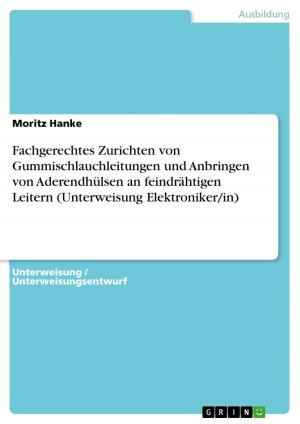| Author: | Susanne Mayer | ISBN: | 9783638523417 |
| Publisher: | GRIN Verlag | Publication: | July 19, 2006 |
| Imprint: | GRIN Verlag | Language: | English |
| Author: | Susanne Mayer |
| ISBN: | 9783638523417 |
| Publisher: | GRIN Verlag |
| Publication: | July 19, 2006 |
| Imprint: | GRIN Verlag |
| Language: | English |
Essay from the year 2006 in the subject Cultural Studies - East European Studies, grade: 1,9, University of Cooperative Education Mannheim, course: Intercultural Management, 20 entries in the bibliography, language: English, abstract: The 'Republika Slovenija' is one of the new republics formed with the dissolution of Yugoslavia. It lies at the heart of Europe, neighbors are Austria, Hungary, Croatia and Italy. With its small transition economy and population of approximately two million, Slovenia is a model of economic success and stability for its neighbors in the former Yugoslavia. The country, which joined the EU in 2004, enjoys a GDP per capita substantially higher than any of the other transitioning economies of Central Europe. Slovenia plans to adopt the Euro by 2007 and has met the ECU's Maastricht criteria for inflation. (www.nationbynation.com/Slovenia/Economy.html&h=288&w=434&sz=12&tbnid=TD7) Despite its economic success, Slovenia also faces challenges. The economy which is currently mostly in state hands needs to be privatized, taxes are relatively high, and the labor market is often seen as inflexible. (www.nationbynation.com/Slovenia/Economy.html&h=288&w=434&sz=12&tbnid=TD7) The population of approximately two million Slovenians includes about 6,300 Hungarians and 2,300 Italians who form the two indigenous minorities whose rights are protected under the Constitution. Other ethnic groups include Croats, Serbs, Bosnians (Muslims), Yugoslavs, Macedonians, Montenegrins and Albanians. Population density is 98.3 inhabitants per km², which is much lower than in the majority of other European states (www.matkurja.com/en/country-info/) The following tables and charts give more detailed information about education, politics, religion, and economy and in Slovenia.
Essay from the year 2006 in the subject Cultural Studies - East European Studies, grade: 1,9, University of Cooperative Education Mannheim, course: Intercultural Management, 20 entries in the bibliography, language: English, abstract: The 'Republika Slovenija' is one of the new republics formed with the dissolution of Yugoslavia. It lies at the heart of Europe, neighbors are Austria, Hungary, Croatia and Italy. With its small transition economy and population of approximately two million, Slovenia is a model of economic success and stability for its neighbors in the former Yugoslavia. The country, which joined the EU in 2004, enjoys a GDP per capita substantially higher than any of the other transitioning economies of Central Europe. Slovenia plans to adopt the Euro by 2007 and has met the ECU's Maastricht criteria for inflation. (www.nationbynation.com/Slovenia/Economy.html&h=288&w=434&sz=12&tbnid=TD7) Despite its economic success, Slovenia also faces challenges. The economy which is currently mostly in state hands needs to be privatized, taxes are relatively high, and the labor market is often seen as inflexible. (www.nationbynation.com/Slovenia/Economy.html&h=288&w=434&sz=12&tbnid=TD7) The population of approximately two million Slovenians includes about 6,300 Hungarians and 2,300 Italians who form the two indigenous minorities whose rights are protected under the Constitution. Other ethnic groups include Croats, Serbs, Bosnians (Muslims), Yugoslavs, Macedonians, Montenegrins and Albanians. Population density is 98.3 inhabitants per km², which is much lower than in the majority of other European states (www.matkurja.com/en/country-info/) The following tables and charts give more detailed information about education, politics, religion, and economy and in Slovenia.















